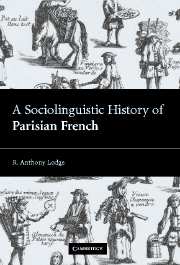Book contents
- Frontmatter
- Contents
- List of maps
- List of tables
- List of figures
- Acknowledgments
- List of phonetic symbols
- Part 1 Preliminaries
- Part 2 The pre-industrial city
- Part 3 The proto-industrial city
- Part 4 The industrial city
- 10 Industrial growth, 1750–1950
- 11 Standardisation and dialect-levelling
- 12 Lexical variation
- Conclusion
- Appendix Literary imitations of low-class speech
- Bibliography
- Index
11 - Standardisation and dialect-levelling
Published online by Cambridge University Press: 22 September 2009
- Frontmatter
- Contents
- List of maps
- List of tables
- List of figures
- Acknowledgments
- List of phonetic symbols
- Part 1 Preliminaries
- Part 2 The pre-industrial city
- Part 3 The proto-industrial city
- Part 4 The industrial city
- 10 Industrial growth, 1750–1950
- 11 Standardisation and dialect-levelling
- 12 Lexical variation
- Conclusion
- Appendix Literary imitations of low-class speech
- Bibliography
- Index
Summary
The effects of industrialisation on the language of a city are contradictory: some are conducive to a reduction in variation, while others lead to an increase. In large-scale environments linguistic homogeneity is promoted by downward diffusion of the standard language and by dialect-levelling, but in smaller-scale environments speakers are forever anxious to preserve their class- and ethnic identities and to use language to this end. In the last two chapters we will see to what extent these patterns were followed in nineteenth- and early twentieth-century Paris.
‘Dialect-levelling’ is an umbrella term under which different authors subsume a variety of linguistic processes. Hinskens (1992: 11) defines it in the following way:
a process which reduces the number of features separating a dialect from other varieties, including the socially more prestigious standard language.
Armstrong (2001: 4) likewise sees the pressure for dialect-levelling coming from two directions: horizontally, from an increase in contacts between speakers of different dialects of roughly equal status, entailing a proportionate increase in individual acts of accommodation, and vertically from the downward pressure exerted by the standard language, particularly as a result of education and literacy programmes.
Trudgill (1986: 98) considers that the linguistic effects of dialect-levelling involve ‘the reduction or attrition of marked variants’ in contact situations. The notion of markedness is, of course, a relative one, implying the presence of forms that are unusual in some way (cf. ‘salience’, § 6.2.2).
- Type
- Chapter
- Information
- A Sociolinguistic History of Parisian French , pp. 205 - 227Publisher: Cambridge University PressPrint publication year: 2004

